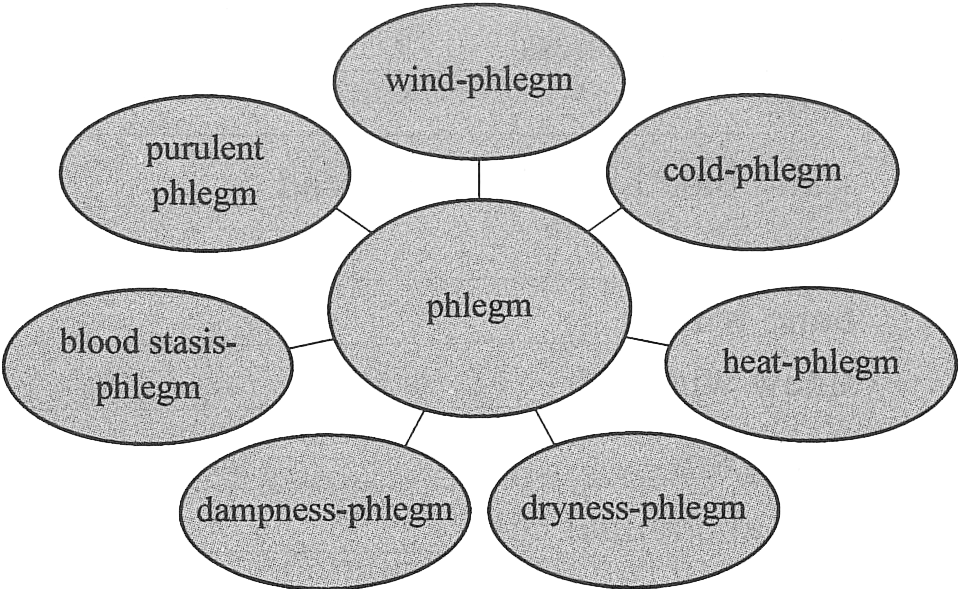
Fig. 5-4 Seven types of phlegm
Text
Pathological products are the pathogenic substances produced during the courses of diseases. Therefore, they are also called secondary causes of diseases. Pathological products mainly include phlegm-retained fluid, static blood and calculus (stone).
Phlegm-Retained Fluid
痰饮
Phlegm- retained fluid is a combination of phlegm and retained fluid as an entity that can cause disease, also called phlegm-fluid retention.
Phlegm, retained fluid*, water and dampness share the same source and can cause diseases. Phlegm is viscus; retained fluid is relatively clear and watery; water is more clear; and dampness means slightly wet. When dampness gathers, it forms water; water accumulates into retained fluid, and retained fluid congeals into phlegm. Though the names are different, in most cases they can not be distinguished and can be combined, such as phlegm-retained fluid, water-dampness and dampness-phlegm. They are pathological products resulting from the metabolic disorders of bodily fluids. Once they are formed, they act as disease-producing factors in the body by blocking the meridians and collaterals, impeding* the circulation of qi and blood, and impairing the functions of the viscera and bowels.
Phlegm, in a narrow sense, refers to pathologic secretions of the diseased respiratory tract, which is known as sputum. In a broad sense, phlegm is the viscous turbid pathological product that can accumulate in the body, causing a variety of diseases.
Clinically, there are seven types of phlegm in TCM as listed in Fig. 5-4.
Purulent phlegm* is the combination of pus with phlegm in the lungs, marked by expectoration of pus or purulent sputum. Blood stasis-phlegm* is formed when turbid phlegm combined with static blood obstructs the qi dynamic, marked by formation of masses with local stabbing pain, or numbness and wilting of the involved area.

Fig. 5-4 Seven types of phlegm
Retained fluid is a watery pathological product resulting from disordered fluid metabolism — also called fluid retention. There are seven types of retained fluid: phlegm-retained fluid*, pleural fluid retention*, subcutaneous fluid retention*, thoracic fluid retention*, mild fluid retention*, persistent fluid retention*, and recurrent fluid retention*, as listed in Fig. 5-5.

Fig. 5-5 Types of retained fluid
Static Blood
瘀血
Static blood is a pathological product of blood stagnation, including extravasated* blood, blood circulating sluggishly, or blood congested in a viscus, all of which may turn into pathogenic factors.
Any factors that can inhibit blood circulation or cause the blood to be out of the vessel can give rise to blood stasis. The heart, lungs, liver and spleen play important roles in blood circulation. Six excesses, seven emotions, or traumatic injuries can all result in static blood either through impairing the functions of these organs or directly impairing the vessels.
When blood becomes stagnant, it not only loses its normal physiological function, but also causes diseases. Blood carries qi and qi has to exist in the blood. Static blood affects the qi dynamic. Static blood in or out of the blood vessels can lead to abnormal blood circulation in the affected area or all over the body depending on where it is located. Static blood in the heart vessel may cause heart vessel obstruction; static blood in the liver may cause its vessels to be blocked. Static blood may cause malfunction of the viscera and bowels, affecting the production of new blood.
The pain caused by static blood is almost always in the same place, it is stabbing in nature, and worsens on palpation. Stagnant blood can cause various kinds of clinical syndromes, according to the sites where it lodges and the amount.
Calculus
结石
Calculus is an abnormal concretion in the body usually consisting of mineral salts and most commonly found in the gallbladder, kidneys, or urinary bladder. Calculus is also called stone. The common causes are improper diet, emotional damage to internal organs, and improper use of medicine.
Calculus usually results from long accumulation of turbid substances and it is hard to dissolve; therefore it usually has a long clinical course. Its common clinical manifestation is pain, mostly colic.